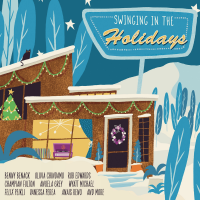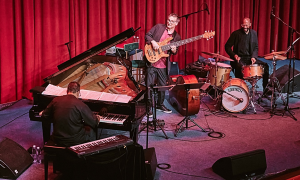Home » Jazz Articles » Profile » Cecil Taylor: Mr. Taylor's Filibuster
Cecil Taylor: Mr. Taylor's Filibuster
...that four-letter word beginning with

A conversation with Taylor, as it turns out, is no less dizzying. The pianist agreed to an interview only on the condition that it not be “that kind of interview.” He didn’t elaborate, I didn’t ask. Some things require a leap of faith. “It sounds like we’ll both have things to talk about,” I suggested, and while we both did, having prepared questions doesn’t guarantee an opportunity to ask them.
Taylor perhaps is also well known for beginning his performances in a less-than-timely way, and so, too, began our interview. He has lived in a three-story brownstone in the Fort Greene section of Brooklyn since 1983, a building he is now in the process of buying. Only the numeral “1” remains of the three digits of his address on his front door, but a framed Cecil Taylor and Mary Lou Williams poster is visible through the curtain, identifying it as the right residence - a small comfort while waiting, and waiting, for someone to come to the door.
A long single room on the second floor serves as an office and sitting room. Lena Horne and Mal Waldron CDs are visible on top of the play stacks. The walls are filled with African masks and tapestries, more framed concert posters and photos clipped from newspapers. Among the newspaper clippings is a rendering of a Frank Gehry building proposed for lower Manhattan. Taylor’s home is a few blocks from the Brooklyn Academy of Music and just north of where a proposed stadium for the Nets would be. Gehry’s name has been attached to the development.
Outfitted in a skull cap, sunglasses, dress shirt, sweat pants and (at least) two pair of socks, Taylor spoke about developers and structural engineers, about black entertainment moguls over the decades (a rapper is said to be financing the stadium, though he doesn’t remember the name) and about Gehry’s work. He then wandered to the window. “If you look at the limbs of these trees,” he said, “nature still wins.”
He didn’t sit for the 90 minutes he held court, walking circles around the large room, smoking American Spirits and drinking tap water from a champagne glass. His talk is fast and his thoughts clearly faster; many of his segues are, to the listener, just a matter of trust. He recalled the composer Iannis Xenakis saying that it would take him six months to figure out a 30-minute Cecil Taylor piece. Xenakis is “my favorite European composer,” Taylor continued, but then quickly changed the subject to a Sonny Rollins concert he and Betty Carter attended on a cruise ship. He then spoke of being in a room with Duke Ellington and Richard Nixon (“History will remember who the real president was.”), and went on to explain that “the artists who receive the most notoriety are generally a reflection of who’s in the White House, and given what is being played today, this generally appears to be true.”
In the five decades he’s been recording, Cecil Percival Taylor has not been without notice, however.
He is a recipient of the MacArthur “genius” grant, performed at the White House for Jimmy Carter, and has honorary degrees from a number of universities. “Columbia a couple of months ago gave me a doctorate,” he said. “Of course, they don’t give you any jobs.”
For someone who could, with little argument, be called the one of the last remaining progenitors of the 1960s “New Thing”, Taylor speaks at length and often about vocalists. But then, that maybe shouldn’t be a surprise for someone who released a record in 1959 called Cecil Taylor Plays Cole Porter. Even then, his modus operandi was evident. The Porter themes, which only constitute about half the record, are interpolated, expanded, and sometimes left on the wayside. He remembers seeing Billie Holiday when he was 13 and thinking “What she did to me, I would like to do to an audience.” He speaks fondly of Lena Horne and Ella Fitzgerald, and notes that they and Holiday were all born between 1915 and 1917. “What a gift the American people got in those three years.” He also holds Betty Carter in no less esteem, as a vocalist and instrumentalist. “As a pianist, she knows exactly what notes to hit,” he said. Bessie Smith, Ethel Waters, Ivie Anderson and Frank Sinatra have all caught his ear. More recently, Taylor has been paying close attention to Frankie Paris, a little known singer who performs four nights a week at Arthur’s Tavern in Manhattan’s West Village. Taylor is frequently in the audience.
Instrumentalists don’t seem to win his love as easily. Charles Mingus was “not great,” he said, although “he certainly brought a new kind of technical ability to the instrument.” To find the jazz musicians he most loves, one needs to reach further back, to Lennie Tristano or the members of his beloved Duke Ellington Orchestra. Jimmy Blanton, the bassist for Ellington’s legendary band of the late ‘30s and early ‘40s “reminds me of Barry Guy,” he said. “There are no bassists in America like Barry Guy.”
Even with his love for the early days of jazz, Taylor shows no regard for the neo-romantics that took over jazz in the ‘80s. Wynton Marsalis, he wryly noted, “rose during the Reagan administration.” He told a story of a meeting with Marsalis.
“Could you dance to James Brown?” Taylor asked the young trumpeter.
“Well, sure,” he replied.
“Could you dance to Albert Ayler?”
Taylor recalls Marsalis stammering and not answering. “Well, I can dance to both,” he shot back.
Ten years ago, Taylor marked his 65th birthday with a solo concert at Lincoln Center’s Alice Tully Hall. He began the performance, as he often does, with poetry, an emotional performance of vocalese ending with the repeated sentence “Praise the music in a proper space.” Like performances by the Art Ensemble of Chicago and Ornette Coleman that would be at the esteemed institution in the coming years, the concert was notably not a part of Marsalis’ Jazz at Lincoln Center programming. If that can be read as Marsalis slighting Taylor, or the avant-garde (and anyone who has heard Marsalis speak on the subject knows that’s not much of a leap), Taylor has little regard for Marsalis’ music as well.
“Everybody has a voice, it depends on what you make me feel with that voice,” he said. “You don’t have to be an innovator, but you must have integrity and you must know how to make your instrument live. Dexter [Gordon] was so beautiful. Dexter used to do this thing, before he’d play a ballad he’d pick up his tenor and cradle it like a baby.”
If Marsalis represents the current face of jazz, Taylor said, he would gladly divorce himself from the word. And in fact, he has long rejected use of the term. Despite popular belief - even perhaps despite appearances - Taylor’s music is largely composed and highly structured. People seeing him for the first time are often surprised to see the maestro and his musicians reading from scores. He doesn’t use traditional notation, but he does - like any composer - create a piece and rehearse his bands. Six weeks before his string of 75th birthday concerts (March 23rd-28th at Iridium, a midtown club that, with increasingly interesting bookings, might be starting to prove itself as a “proper space”), Taylor was already rehearsing the 16-piece band that will take on the challenge of his dense music.
But that music, he reiterated, isn’t jazz.
“The word ‘jazz’ is inappropriate,” he said. “Ellington called his music ‘Ellingtonia.’ Jazz is connected with the brothel houses in New Orleans.”
After an hour and a half of free associating, I was granted a question. “What did you mean you wouldn’t do ‘that kind of interview’?” I asked.
“Well, that’s why I’ve been talking so much,” began his next soliloquy. And with that began a lecture on history and musicology.
“The American Indians here stomp,” he said, pounding his foot to the floor. “It is rhythm. It is acknowledging the food and the Earth.” He drew a quick line between aboriginal music and Louis Armstrong. “That’s why that four-letter word beginning with ‘J’ and ending with ‘Z’ is so inadequate. It does not encapsulate what was brought here and developed. If Adolphe Sax invented the saxophone [he laughs], it was nothing compared to the way it was played by Ben Webster and Charlie Parker and John Coltrane and Albert Ayler.”
“I’ve learned as much from Marvin Gaye as I have from Thelonious Monk,” he said. “James Brown is really a genius. The most important thing about music is the rotation of the earth as it moves through the rays of the sun. The seasons happen in a cyclical manner. It is how we come into being. Fucking is just rhythmical, you know.”
Recommended Listening
Jazz Advance (Transition-Blue Note, 1955)
Looking Ahead (Contemporary-OJC, 1958)
Nefertiti, the Beautiful One Has Come [live] (Revenant, 1962)
Unit Structures (Blue Note, 1966)
The Great Concert (Shandar-Prestige, 1969)
The Willisau Concert (Intakt, 2002)
Photo Credit
Photo: Francesca Pfeffer
Tags
PREVIOUS / NEXT
Support All About Jazz
 All About Jazz has been a pillar of jazz since 1995, championing it as an art form and, more importantly, supporting the musicians who make it. Our enduring commitment has made "AAJ" one of the most culturally important websites of its kind, read by hundreds of thousands of fans, musicians and industry figures every month.
All About Jazz has been a pillar of jazz since 1995, championing it as an art form and, more importantly, supporting the musicians who make it. Our enduring commitment has made "AAJ" one of the most culturally important websites of its kind, read by hundreds of thousands of fans, musicians and industry figures every month.




























